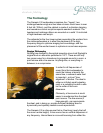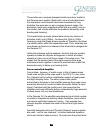
21
2121
21
absolute fidelity
floor or the ceiling. No deleterious interference from these surfaces
is created (as in virtually all other kinds of speakers).
Another advantage of the line source is that the vertical spectral
content of music is virtually the same throughout the length of the
line source. Hence, the seating height does not matter with this
speaker; unlike point source speakers where it is important for the
ears to be aligned in relationship with the tweeter.
The Genesis 2.2 is also a dipole radiator. The midrange and
tweeter drivers are mounted on a rigid acrylic panel with no
enclosure. This has two advantages: firstly, it eliminates any
enclosure or boxy colorations caused by cabinet vibrations or
resonance.
Secondly, the dipole creates a cardioid pattern (like a figure-eight),
which has its maximum output at the listening position and behind
the speaker itself, and minimum output to the sides in the plane of
the loudspeakers. This very effectively minimizes the bounce from
the sidewalls.
Hence, in conjunction with the line source, the G2.2 has no first
reflection from the floor, ceiling or sidewalls. The net result is that
there are far fewer detail-robbing room reflections from the room
than other types of loudspeakers. With fewer spurious reflections to
confuse your hearing, the program source emerges more clearly.
Imaging is deeper, yet more focused.
This results in a loudspeaker system that is virtually room-
independent. Also, because there are no phase and frequency
distorting reflections created, one can be transported into the
audience of the actual concert hall where the music was recorded.
The Genesis Ribbon Tweeter
Reviewers in the Audiophile press have often remarked that the
Genesis circular ribbon tweeter is the world’s best. It is a one inch
circular planar ribbon design crafted from an extremely thin
membrane of Kapton with a photo-etched aluminium “voice coil”
that is a mere 0.0005 inch thick. The entire radiating structure has
less mass than the air in front of it! That is why it will accurately
reproduce frequencies to 36 kHz.
The result of this design is a driver that has a rapid and uniform
response to high frequencies, and has the speed of the best


















